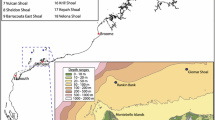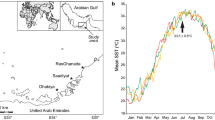Abstract
Despite the fact that molluscs are one of the most widespread and conspicuous of all marine invertebrates, comparatively little is known about their ecology, especially with respect to biological interactions that drive community processes. We consequently assessed patterns of subtidal mollusc assemblages on subtropical rocky reefs in the Solitary Islands Marine Park (SIMP), eastern Australia. Shelled molluscs (specifically shelled gastropods and bivalves) were targeted to test if: (1) mollusc assemblages change with increasing distance from shore; (2) reef orientation (vertical and horizontal reef faces) influences assemblage structure; (3) sessile benthic communities influence the composition of mollusc assemblages. Multivariate analyses of community patterns indicated strong cross-shelf patterns. However, no significant differences were found for summary community variables (species richness, total abundance). Inshore sites were dominated by large herbivores (especially turbinids) and prey-specific ranellids. Mid-shelf assemblages comprised a mix of taxa that occurred in both inshore and offshore assemblages and were thus transitional between these shelf positions. Offshore assemblages were distinctly different to reefs closer to shore and were characterised primarily by the presence of sedentary (Vermetidae and Chamidae), and tropically-affiliated taxa. Relationships with reef orientations were found to be inconsistent and correlations with sessile benthos were relatively weak. The overall patterns are similar to those found for corals and fish in the region and most likely reflect the increasing influence of the East Australian Current offshore.




Similar content being viewed by others
References
Anderson MJ, Gorley RN, Clarke KR (2008) PERMANOVA+ for PRIMER: guide to software and statistical methods. PRIMER-E, Plymouth, UK
Anderson MJ, Millar RB (2004) Spatial variation and effects of habitat on temperate reef fish assemblages in northeastern New Zealand. J Exp Mar Biol Ecol 305(2):191–221
Andrew NL (1993) Spatial heterogeneity, sea urchin grazing, and habitat structure on reefs in temperate Australia. Ecol 74(2):292–302
Andrew NL, Mapstone BD (1987) Sampling and the description of spatial pattern in marine ecology. Oceanogr Mar Biol Annu Rev 25:39–90
Bouchet P, Lozouet P, Maestrati P, Heros V (2002) Assessing the magnitude of species richness in tropical marine environments: exceptionally high numbers of molluscs at a New Caledonia site. Biol J Linn Soc 75(4):421–436
Clarke A, Huw JG, Katrin L, David KAB, Crame JA (2007) How well do we know the Antarctic marine fauna? A preliminary study of macroecological and biogeographical patterns in southern ocean gastropod and bivalve molluscs. Divers Distrib 13(5):620–632
Clarke KR (1993) Non-parametric multivariate analyses of changes in community structure. Aust J Ecol 18:117–143
Clarke KR, Gorley RN (2006) Primer v6: user manual/tutorial. PRIMER-E, Plymouth
Day RW, Quinn GP (1989) Comparisons of treatments after an analysis of variance in ecology. Ecol Monogr 59:433–463
Field JG, Clarke KR, Warwick RM (1982) A practical strategy for analysing multispecies distribution patterns. Mar Ecol Prog Ser 8:37–52
Glasby TM (2000) Surface composition and orientation interact to affect subtidal epibiota. J Exp Mar Biol Ecol 248(2):177–190
Glasby TM, Connell SD (2001) Orientation and position of substrata have large effects on epibiotic assemblages. Mar Ecol Prog Ser 214:127–135
Gosliner T, Behrens DW, Williams GC (1996) Coral reef animals of the Indo-Pacific. Sea Challengers, Monterey
Gosliner TM, Draheim R (1996) Indo-Pacific opisthobranch gastropod biogeography: How do we know what we don't know? Am Malacol Bull 12:37–43
Gray JS, Clarke KR, Warwick RM, Hobbs G (1990) Detection of initial effects of pollution on marine benthos: An example from the ekofisk and eldfisk oilfields, north sea. Mar Ecol Prog Ser 66:285–299
Harriott VJ, Smith SDA, Harrison PL (1994) Patterns of coral community structure of subtropical reefs in the Solitary Islands Marine Reserve, Eastern Australia. Mar Ecol Prog Ser 109:67–76
Harrison MA (2003) Interactions between wave exposure and habitat complexity in determining patterns of subtidal community structure. Honours thesis, University of New England, Armidale
Knott NA, Underwood AJ, Chapman MG, Glasby TM (2004) Epibiota on vertical and on horizontal surfaces on natural reefs and on artificial structures. J Mar Biol Assoc UK 84(06):1117–1130. doi:10.1017/S0025315404010550h
Kohler KE, Gill SM (2006) Coral point count with excel extensions (CPCe): a visual basic program for the determination of coral and substrate coverage using random point count methodology. Comput Geosci 32(9):1259–1269
Kohn AJ (1968) Microhabitats, abundance and food of Conus on atoll reefs in the Maldive and Chagos Islands. Ecol 49(6):1046–1062
Malcolm HA, Jordan A, Smith SDA (2010a) Biogeographical and cross-shelf patterns of reef fish assemblages in a transition zone. Mar Biodivers 40(3):181–193. doi:10.1007/s12526-010-0042-3
Malcolm HA, Smith SDA, Jordan A (2010b) Using patterns of reef fish assemblages to refine a habitat classification system for marine parks in NSW, Australia. Aquatic Conservation. Mar Freshw Ecosyst 20:83–92. doi:10.1002/aqc.1055
Malcolm HA, Davies PL, Jordan A, Smith SDA (2011) Variation in sea temperatures and the East Australian Current in the Solitary Islands region between 2001–2008. Deep Sea Research Part II. Top Stud Oceanogr 58:616–627
Marine Parks Authority (2000) Solitary Islands Marine Park (NSW), Solitary Islands Marine Reserve (Commonwealth). Planning issues and option paper. Marine Parks Authority, Sydney
McClanahan TR (1990) Kenyan coral reef-associated gastropod assemblages: distribution and diversity patterns. Coral Reefs 9:63–74
McClanahan TR (1994) Coral-eating snail Drupella cornus population increases in Kenyan coral-reef lagoons. Mar Ecol Prog Ser 115(1–2):131–137
Miller RJ, Etter RJ (2011) Rock walls: small-scale diversity hotspots in the subtidal Gulf of Maine. Mar Ecol Prog Ser 425:153–165. doi:10.3354/meps09025
Pante E, Adjeroud M, Dustan P, Penin L, Schrimm M (2006) Spatial patterns of benthic invertebrate assemblages within atoll lagoons: Importance of habitat heterogeneity and considerations for marine protected area design in French Polynesia. Aquat Living Resour 19(3):207–217. doi:10.1051/alr:2006021
Posthuma-Gribic S (2007) The distribution of echinoderms within the Solitary Islands Marine Park: examination of cross-shelf and depth-asscociated patterns. Honours Thesis, University of New England, Armidale
Rule MJ, Smith SDA (2007) Depth-associated patterns in the development of benthic assemblages on artificial substrata deployed on shallow, subtropical reefs. J Exp Mar Biol Ecol 345(1):38–51
Smith SDA (2000) The Solitary Islands. In: Andrew NL (ed) Under southern seas. The ecology of Australian rocky shores. University of New South Wales Press, Sydney
Smith SDA (2005) Rapid assessment of invertebrate biodiversity on rocky shores: where there’s a whelk there's a way. Biodivers Conserv 14(14):3565–3576
Smith SDA, Edgar RJ (1999) Description and comparison of benthic community structure within the Solitary Islands Marine Park. Solitary Islands Underwater Research Group Inc. Report prepared for Environment Australia, Canberra
Smith SDA, Rule MJ, Harrison M, Dalton SJ (2008) Monitoring the sea change: preliminary assessment of the conservation value of near shore reefs, and existing impacts, in a high-growth, coastal region of subtropical Eastern Australia. Mar Pollut Bull 56:525–534
Smith SDA, Simpson RD (1991) Nearshore corals of the Coffs Harbour region, mid north coast, New South Wales. Wetl Aust 11:1–9
Smith SDA, Simpson RD (1992) Monitoring the shallow sublittoral using the fauna of kelp (Ecklonia radiata) holdfasts. Mar Pollut Bull 24(1):46–52
Terlizzi A, Scuderi D, Fraschetti S, Guidetti P, Boero E (2003) Molluscs on subtidal cliffs: Patterns of spatial distribution. J Mar Biol Assoc UK 83(1):165–172
Underwood AJ (2000) Experimental ecology of rocky intertidal habitats: what are we learning? J Exp Mar Biol Ecol 250(1–2):51–76
Underwood AJ, Chapman MG (1996) Scales of spatial patterns of distribution of intertidal invertebrates. Oecologia 107(2):212–224
Underwood AJ, Kingsford MJ, Andrew NL (1991) Patterns in shallow subtidal marine assemblages along the coast of New South Wales. Aust J Ecol 16:231–249
Vanderklift MA, Kendrick GA (2004) Variation in abundances of herbivorous invertebrates in temperate subtidal rocky reef habitats. Mar Freshw Res 55(1):93–103
Veron JEN, How RA, Done TJ, Zell LD, Dodkin MJ, O'Farell AF (1974) Corals of the Solitary Islands, central New South Wales. Aust J Mar Freshw Res 25:193–208
Warwick RM, Clarke KR (1993) Increased variability as a symptom of stress in marine communities. J Exp Mar Biol Ecol 172:215–226
Wernberg T, White M, Vanderklift MA (2008) Population structure of turbinid gastropods on wave-exposed subtidal reefs: effects of density, body size and algae on grazing behaviour. Mar Ecol Prog Ser 362:169–179. doi:10.3354/meps07416
Zann LP (2000) The Eastern Australian region: a dynamic tropical/temperate biotone. Mar Pollut Bull 41(1–6):188–203
Zuschin, Hohenegger, Steininger (2001) Molluscan assemblages on coral reefs and associated hard substrata in the northern Red Sea. Coral Reefs 20(2):107–116
Zuschin M, Piller WE (1997) Molluscan hard-substrate associations in the northern Red Sea. Mar Ecol-Pubblic Della Stazione Zoologica Di Napoli I 18(4):361–378
Acknowledgements
This study was conducted with support from the School of Environmental and Rural Science and the National Marine Science Centre, University of New England. Many thanks to the individuals that assisted with fieldwork Michael Rule, Steven Dalton, Andrew Cox, Rod Forbes and Andrew Dingle.
Author information
Authors and Affiliations
Corresponding author
Appendix
Appendix
Rights and permissions
About this article
Cite this article
Harrison, M.A., Smith, S.D.A. Cross-shelf variation in the structure of molluscan assemblages on shallow, rocky reefs in subtropical, eastern Australia. Mar Biodiv 42, 203–216 (2012). https://doi.org/10.1007/s12526-011-0105-0
Received:
Revised:
Accepted:
Published:
Issue Date:
DOI: https://doi.org/10.1007/s12526-011-0105-0




